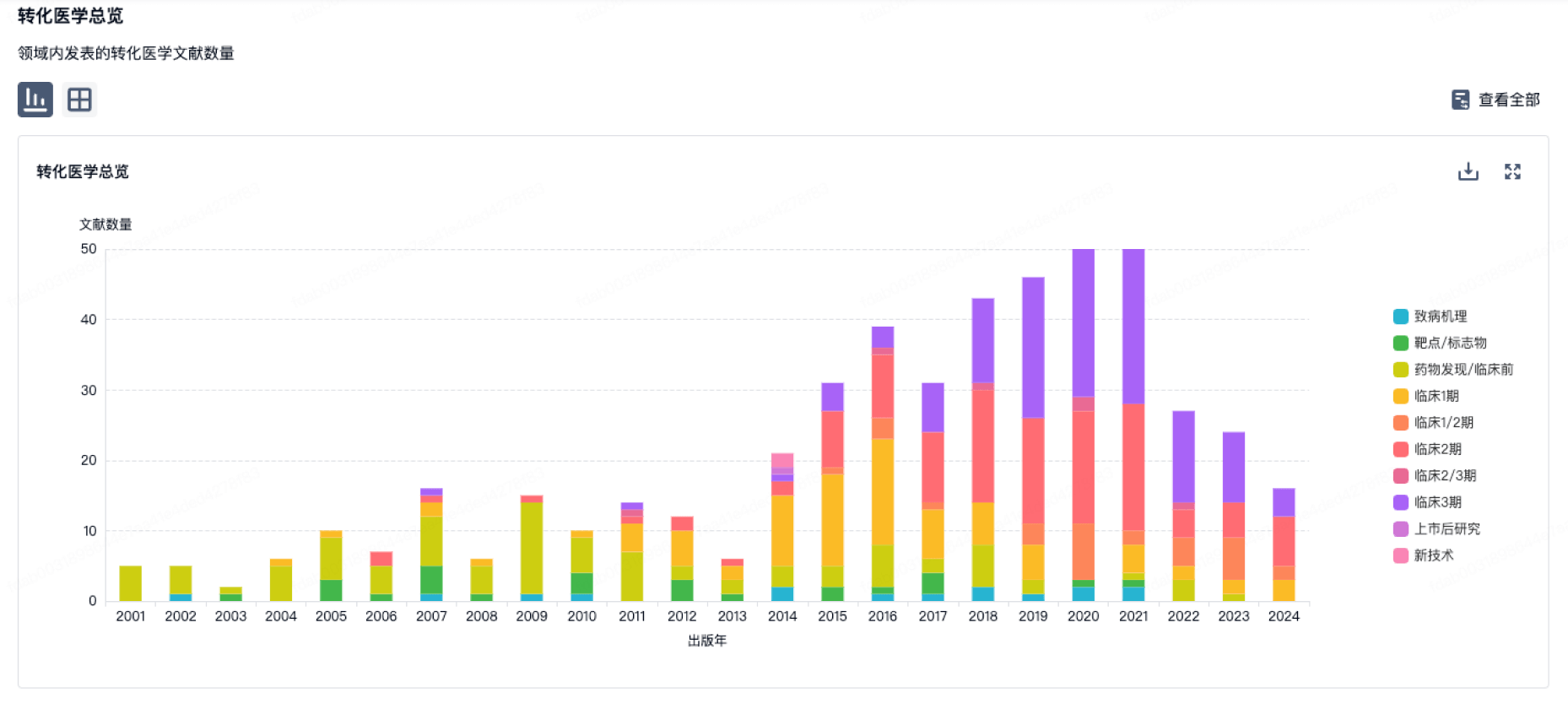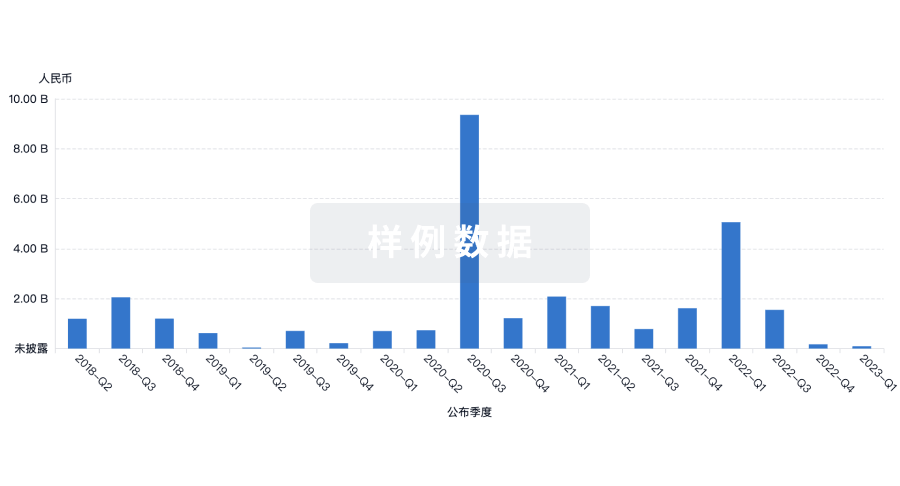预约演示
更新于:2025-11-09
Beijing Institute of Microbiology & Epidemiology
北京微生物流行病研究所|教育|中国北京市
北京微生物流行病研究所|教育|中国北京市
更新于:2025-11-09
概览
标签
其他疾病
感染
抗毒素
减毒活疫苗
预防性疫苗
疾病领域得分
一眼洞穿机构专注的疾病领域
暂无数据
技术平台
公司药物应用最多的技术
暂无数据
靶点
公司最常开发的靶点
暂无数据
| 疾病领域 | 数量 |
|---|---|
| 感染 | 2 |
| 排名前五的药物类型 | 数量 |
|---|---|
| 抗毒素 | 2 |
| 减毒活疫苗 | 1 |
| 预防性疫苗 | 1 |
| 排名前五的靶点 | 数量 |
|---|---|
| ZIKV E protein(寨卡病毒E蛋白) | 1 |
关联
3
项与 北京微生物流行病研究所 相关的药物靶点- |
作用机制- |
在研机构 |
原研机构- |
在研适应症 |
非在研适应症- |
最高研发阶段临床1期 |
首次获批国家/地区- |
首次获批日期- |
靶点- |
作用机制- |
在研机构 |
原研机构- |
在研适应症 |
非在研适应症- |
最高研发阶段临床1期 |
首次获批国家/地区- |
首次获批日期- |
作用机制 ZIKV E protein抑制剂 |
在研机构 |
原研机构 |
在研适应症 |
非在研适应症- |
最高研发阶段临床前 |
首次获批国家/地区- |
首次获批日期- |
8
项与 北京微生物流行病研究所 相关的临床试验ChiCTR2300076238
Clinical efficacy of therapy with all-trans retinoic acid in patients with severe fever with thrombocytopenia syndrome
开始日期2023-06-01 |
申办/合作机构 北京微生物流行病研究所 [+2] |
CTR20200935
法匹拉韦片在中国成年健康志愿者中随机、开放、两制剂、两周期生物等效性研究
主要目的: 健康成年受试者空腹和餐后口服单剂量法匹拉韦片受试制剂与参比制剂后,以药代动力学参数为终点评价指标, 评价北京四环制药有限公司生产的法匹拉韦片是否与 Toyama Chemical Co,Ltd 的参比制剂(商品名: AVIGAN®,规格 200mg)具有生物等效性。 次要目的: 观察受试制剂法匹拉韦片和参比制剂 AVIGAN®在健康受试者中的安全性。
开始日期2020-06-25 |
申办/合作机构  北京四环制药有限公司 北京四环制药有限公司 [+1] |
ChiCTR1800015894
Clinical efficacy of therapy with T-705 in patients with severe fever with thrombocytopenia syndrome
开始日期2018-04-17 |
申办/合作机构 北京微生物流行病研究所 [+1] |
100 项与 北京微生物流行病研究所 相关的临床结果
登录后查看更多信息
0 项与 北京微生物流行病研究所 相关的专利(医药)
登录后查看更多信息
1,617
项与 北京微生物流行病研究所 相关的文献(医药)2025-10-01·CELL
Structural basis for the concurrence of template recycling and RNA capping in SARS-CoV-2
Article
作者: Guddat, Luke W ; Huang, Yucen ; Ye, Sihan ; Liu, Lu ; Ge, Ji ; Xiong, Jiangran ; Rao, Zihe ; Gao, Yan ; Zhao, Xiaoyue ; Gao, Shan ; Liu, Zhenyu ; Zhu, Lan ; Wang, Junbo ; Zhou, Yu ; Tan, Liping ; Lou, Zhiyong ; Yan, Liming ; Zhao, Hesheng ; Liu, Yixiao
In the SARS-CoV-2 replication-transcription complex (RTC), the nascent template-product duplex is unwound into a template strand for recycling and a product strand that needs to be capped. Here, we determined structures of the SARS-CoV-2 RTC in the pre- and post-capping initiation (CI) states. In the pre-CI state, the RTC has a dimer-of-dimeric architecture (ddRTC). The upstream RNA duplex in one RTC is reciprocally unwound by a helicase in a head-to-head-positioned RTC in the 3'-5' direction. The helicases bind either ADP or ADP⋅Pi in their ATP-binding pockets, suggesting a mechanism for ATP-hydrolysis-driven unwinding. In the post-CI state, the binding of nsp9 to the nsp12 nidovirus RdRp-associated nucleotidyltransferase (NiRAN) disrupts the ddRTC. The N terminus of nsp9 and the triphosphorylated 5' end of the product strand co-localize in NiRAN's catalytic site, exhibiting the state prior to nsp9 RNAylation for capping. These results provide an insight into the concurrence of template recycling and RNA capping in the SARS-CoV-2 RTC.
2025-09-01·Journal of the Royal Society Interface
Assessing the relative roles of systemic, non-systemic and transovarial transmission pathways for severe fever with thrombocytopaenia syndrome virus and its implications for future research and intervention strategies.
Article
作者: Liu, Wei ; Fang, Li-Qun ; Purse, Bethan V ; Yang, Yang ; Peng, Zhihang ; Cheng, Qu ; Hassall, Richard ; Li, Qi ; Li, Sen
Severe fever with thrombocytopaenia syndrome virus (SFTSV) was identified by the World Health Organization as a priority pathogen due to its high case-fatality rate in humans and rapid spread. It is maintained in nature through three transmission pathways: systemic, non-systemic and transovarial. Understanding the relative contributions of these transmission pathways is crucial for developing evidence-informed public health interventions to reduce its spillover risks to humans. Using next-generation matrices, sensitivity analyses, elasticity analyses and random forest models, we estimated the basic reproduction number R0, relative contribution of each pathway, and identified the most sensitive model parameters across 27 scenarios. Results showed that [Formula: see text] ranged from 0.72 to 2.08 across scenarios, increasing with higher tick abundance and longer viraemia. Transovarial transmission dominated in 26 scenarios, while the importance of the other two varied, with non-systemic transmission more important under high tick abundance, short viraemia or aggregated tick distribution. [Formula: see text] dropped below 1 in all scenarios when transovarial transmission was excluded. These findings emphasize the need for interventions targeting transovarial transmission, such as reducing female adult tick survival and limiting large vertebrate host movement, and underscore the importance of laboratory studies measuring sensitive parameters including transovarial transmission efficiency, tick survival probabilities and the duration of viraemia and potential for non-systemic transmission for key animal host species with high seroprevalence rates.
2025-07-01·HEPATOLOGY
Harnessing ZIKV NS2A RNA for alleviating acute hepatitis and cytokine release storm by targeting translation machinery
Article
作者: He, Yuanqing ; Dai, Jianfeng ; Chen, Zhiqiang ; Yuan, Yi ; Liu, Guodi ; Chen, Shengchuan ; Wu, Rongsheng ; He, Sudan ; Li, Dapei ; Qin, Cheng-Feng ; Ma, Feng ; Wang, Shiyou ; Yao, Haiping ; Liu, Siying ; Zhu, Jingfei ; Yang, Tao
Background and Aims::
Hyperactivated inflammatory responses induced by cytokine release syndrome are the primary causes of tissue damage and even death. The translation process is precisely regulated to control the production of proinflammatory cytokines. However, it is largely unknown whether targeting translation can effectively limit the hyperactivated inflammatory responses during acute hepatitis and graft-versus-host disease.
Approach and Results::
By using in vitro translation and cellular overexpression systems, we have found that the nonstructural protein gene NS2A of Zika virus functions as RNA molecules to suppress the translation of both ectopic genes and endogenous proinflammatory cytokines. Mechanistically, results from RNA pulldown and co-immunoprecipitation assays have demonstrated that NS2A RNA interacts with the translation initiation factor eIF2α to disrupt the dynamic balance of the eIF2/eIF2B complex and translation initiation, which is the rate-limiting step of translation. In the acetaminophen-induced, lipopolysaccharide/D-galactosamine-induced, viral infection-induced acute hepatitis, and graft-versus-host disease mouse models, mice with myeloid cell-specific knock-in of NS2A show decreased levels of serum proinflammatory cytokines and reduced tissue damage.
Conclusions::
Zika virus NS2A dampens the production of proinflammatory cytokines and alleviates inflammatory injuries by interfering translation process as RNA molecules, which suggests that NS2A RNA is potentially used to treat numerous acute inflammatory diseases characterized by cytokine release syndrome.
1
项与 北京微生物流行病研究所 相关的新闻(医药)2023-09-13
·美通社
深圳2023年9月13日 /美通社/ -- 跨越万里丝路,全球筑梦十年。今年是共建"一带一路"倡议提出十周年。健康丝绸之路作为其重要组成部分,连接着中国与世界医疗健康发展的纽带。
理邦作为健康事业的创新先行者,成为丝路共建的重要力量之一,近期来,理邦的多项突破性医疗科技和解决方案在中国国际医用仪器设备展览会(China-Hospeq 2023)暨技术交流会中集中展出,为健康丝路高质量发展赋能。
理邦超声亮相 China-Hospeq 2023
勇闯创新"无人区"
坚持高质可持续性发展路径
"流水不争先,争的是滔滔不绝。"
走创新、可持续的高质量发展路径,是实现国产替代的必由之路。近年来中国医疗器械专利数量在不断增长,包括关键性技术和创新性的发明专利。中国不乏创新,但颠覆性的创新才真正决定了国产替代的进程。在创新的高标准,独特性和前瞻性前提下,理邦不断开辟"无人区",一批自主创新研发的高端产品脱颖而出。
备受关注的新一代旗舰机型F15系列胎儿/母亲监护仪,以自主研发、具有多项专利的胎心电子监护"IQ(正交)解调创新技术",创新独步地解决了胎儿监护"加倍"、"减半"、误测母亲心率等原理性缺陷问题,大幅提升了产程胎儿监护的准确率,凭借该项专利技术,相关临床研究成功收录于Maternal-Fetal Medicine (MFM)杂志,产品同时获得了国家制造业单项冠军产品奖,在中国一大批三甲医院及英国、德国、西班牙、意大利等欧美高端医疗机构顺利装机并得到认可。
以终为始,理邦所有创新的出发点,都源于用户需求和临床痛点。在监护领域,理邦全新一代的iX系列病人监护仪,打造了行业内创新的血压监测技术——CNBP连续无创血压监测。在技术上避免传统无创袖带血压监测间隙期的盲区,在测量上不需要传统袖带充气加压或传统穿刺侵入,为患者提供更安全、舒适的就诊体验,成为行业内血压监测新技术非常重要的实践。
高质量的持续研发创新,是一场循序渐进的持久战。理邦未曾停下攀登顶峰的脚步,探索创新的"无人区",致力打破颠覆式创新稀缺的局面。多年来形成了多层面、多维度、多形式的创新融合,尤其是在理邦成立的国家级博士后工作站,为医疗器械行业领域培养了一批高精尖的人才,推动更多突破性、颠覆式的创新。
多年来,理邦与中科院理化所、解放军总医院联合承担"国家科技支撑计划",与中国人民解放军军事医学科学院微生物流行病研究所联合承担"广东省中国科学院全面战略合作项目",与南方医科大联合建立"广东省重大疾病临床快速诊断生物传感工程技术研究中心",孵化出了拥有70多项国内外专利的i15血气生化分析仪、全球创新的m16磁敏免疫分析仪等一系列国内首创、国际领先的明星产品。
目前正在加速推进湿式血气及第二代干式血气上市,打造"干式+湿式"全产品解决方案,未来几年有望打破国际垄断的局面,实现全链条国产替代。
在不断的突破中,颠覆性的创新研发成果显著。目前理邦国内外授权专利/专利申请达1700余件,2022年7月,公司与广东工业大学共同作为专利权人的"一种基于非负盲分离胎儿心电瞬时心率识别方法及系统"专利获得"第23届中国专利奖银奖",同年10月理邦被评为国家知识产权优势企业,研发实力和知识产权积累不断实现跨越。
与人民日报健康客户端分享理邦“国产替代与出海”进程
"一个有价值的品牌,具有极致创新和可持续发展的品质,它的核心竞争力在于产品本身,并且能够经得起市场的考验。"理邦市场传播与策划总监崔蓉在接受人民日报健康客户端的采访中表示,"在中国国产替代的大环境下,真正做产品、坚持创新的品牌迎来了发展黄金期。"
加速全球化步伐
共赴健康丝路下一个十年
下一个十年,"一带一路"将向"数字丝绸之路"跨越。
"一带一路"健康丝路的朋友圈持续扩大,已经形成了创新技术碰撞交流、开放包容的新格局。在健康丝路迈向高质量发展阶段,理邦"乘风出海"的步伐不断加速。
一方面持续打造本土化闭环生态链,加强本土化服务和体验。另一方面,理邦正加速更智能化、信息化解决方案的海外布局,这也是理邦未来全球化布局的重点之一,以大数据、人工智能技术为代表的"数字丝绸之路"将成为"一带一路"沿线国家医疗发展的新引擎。泰国呵叻府玛哈拉医院是泰国卫生部直属最大的地区性医院,代表着泰国最顶尖的行业水平,拥有超过2000张床位。理邦紧密结合用户的需求,为其提供了定制化的解决方案,400台elite V系列插件式监护仪、150台iM20转运监护仪、50套CMS中央监护系统服务于该医院,助力医院实现信息化升级。
马来西亚赛城医院作为卫生部下属的公立医院,在产科领域一直不断寻求更智能、患者体验更舒适的监护管理模式。理邦产科中央监护系统和F15胎儿/母亲监护仪成为了医院的首选,帮助医院攻破传统胎监壁垒,打造集中监护管理新模式。
结合近三十年的临床实践,理邦Allink智慧联以信息化技术为驱动,提出软硬件一体化的整体解决方案,以一整套完整开放的智慧生态,融入妇幼健康,病人监护、心电诊断、急诊急救、居家健康五大医疗应用场景。
理邦 Allink 智慧联生态
在国内,目前已累计完成超5000家医疗机构及院内临床科室的信息化网络建设,远程心电实现了200W+人次远程诊断服务,妇幼保健服务达到了150W+人次健康管理服务。
对于国际市场,理邦将积极通过与国际各大主流EMR厂商建立合作交流,为理邦设备顺利入驻欧美的主流院内市场夯基蓄势。截止目前,公司已逐步实现了国际大部分主流EMR厂商的技术对接,这将为理邦打开国际发达国家院内市场奠定坚实的技术基础。
"一带一路"倡议源自中国,更属于世界。十年的共荣共长,"让医疗创新成果惠及每个人"的使命迈向了更广阔的世界舞台。下一个十年,我们继续加速全球化步伐,以坚持和突破与健康丝路高质量发展同向而行,共同繁荣。
100 项与 北京微生物流行病研究所 相关的药物交易
登录后查看更多信息
100 项与 北京微生物流行病研究所 相关的转化医学
登录后查看更多信息
组织架构
使用我们的机构树数据加速您的研究。
登录
或

管线布局
2025年11月27日管线快照
管线布局中药物为当前组织机构及其子机构作为药物机构进行统计,早期临床1期并入临床1期,临床1/2期并入临床2期,临床2/3期并入临床3期
临床前
1
2
临床1期
登录后查看更多信息
药物交易
使用我们的药物交易数据加速您的研究。
登录
或

转化医学
使用我们的转化医学数据加速您的研究。
登录
或

营收
使用 Synapse 探索超过 36 万个组织的财务状况。
登录
或

科研基金(NIH)
访问超过 200 万项资助和基金信息,以提升您的研究之旅。
登录
或

投资
深入了解从初创企业到成熟企业的最新公司投资动态。
登录
或

融资
发掘融资趋势以验证和推进您的投资机会。
登录
或

生物医药百科问答
全新生物医药AI Agent 覆盖科研全链路,让突破性发现快人一步
立即开始免费试用!
智慧芽新药情报库是智慧芽专为生命科学人士构建的基于AI的创新药情报平台,助您全方位提升您的研发与决策效率。
立即开始数据试用!
智慧芽新药库数据也通过智慧芽数据服务平台,以API或者数据包形式对外开放,助您更加充分利用智慧芽新药情报信息。
生物序列数据库
生物药研发创新
免费使用
化学结构数据库
小分子化药研发创新
免费使用
